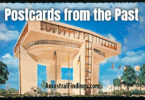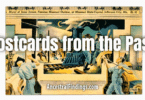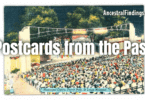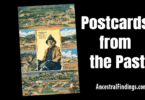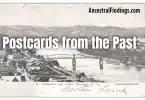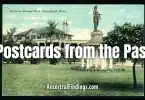This postcard shows Nela Park in Cleveland, Ohio, home to the General Electric Company’s experimental headquarters. More than just an industrial site, Nela Park became one of the most famous research campuses in the United States. It represented innovation, wartime contributions, and the lives of thousands of Cleveland-area families. Mailed in 1944, the card also carries a personal note that connects the grand story of science and industry to the smaller, everyday rhythms of life.
Building Nela Park
When General Electric developed Nela Park in 1913, it created something new: a research campus built like a university. The Georgian-style brick buildings, carefully landscaped grounds, and open lawns stood in stark contrast to the smoke-filled factories that defined much of Cleveland’s industrial landscape.
The name came from the National Electric Lamp Association, which GE had absorbed earlier in the century. Keeping the name was a way of honoring its lighting roots while establishing Nela Park as the place where the future of electric illumination would be shaped.
Inside its laboratories, researchers worked on improvements that touched nearly every American household. More efficient light bulbs, fluorescent lamps, and advances in street lighting all came from experiments at Nela Park.
A Wartime Snapshot
The postmark on this card dates it to 1944, in the middle of World War II. At that time, Nela Park’s work extended far beyond home lighting. Researchers developed lamps for military use, including airfield beacons and ship lighting. Like so many Cleveland industries, GE’s workforce became part of the war effort.
The note written on the back, though, is striking in its simplicity: “Rain, rain. No snow for a long time.” Even in wartime, daily weather and family news still filled the space of postcards. They carried both the weight of the era and the comfort of ordinary conversation.
A Place for the Public
Nela Park wasn’t closed off from the city around it. Cleveland residents came to tour the grounds, see demonstrations of the latest lighting technology, and enjoy the beauty of the landscaped campus.
Perhaps most famously, Nela Park became known for its Christmas lighting displays. Beginning in the 1920s, these annual shows drew thousands of visitors. Families drove through to marvel at electric lights arranged in festive displays, an event that tied the campus not just to science but also to tradition and community celebration.
Cleveland Families and Work Life
Generations of Cleveland families found employment at Nela Park. The lighting division provided steady jobs and, during wartime, expanded opportunities as more women entered industrial work. City directories and census records from neighborhoods like East Cleveland, Cleveland Heights, and Parma often list occupations tied to “lamp works” or GE.
Employment at Nela Park touched entire households. One person might have worked in a laboratory, another in assembly or testing, and still another in clerical work. Families built their lives around the steady wages and sense of pride that came with contributing to an industry that quite literally lit the world.
The Postcard as Record
The image on the front emphasizes beauty and order: red-brick buildings, manicured lawns, and green hills. This was intentional. GE wanted the world to see Nela Park as more than a workplace. It was meant to inspire trust in modern science and pride in Cleveland’s role as a city of progress.
The reverse side tells a smaller, more personal story. The green one-cent “Industry–Agriculture for Defense” stamp ties it firmly to wartime. The brief weather report, sent to a woman in New Hampshire, shows how postcards served as quick notes of connection when phone calls were costly and long-distance letters slower to arrive.
A Legacy That Endures
More than a century after its founding, Nela Park still stands. Though GE has changed over time, the campus remains a Cleveland landmark. It represents the era when scientific research campuses were still new ideas and when American industry projected both strength and beauty.
This postcard brings together several layers of history at once: Cleveland’s role in lighting innovation, the city’s contribution to the war effort, the pride of local families who worked here, and the personal touches of handwritten correspondence.
Invitation to Share
If you have postcards tucked away in albums or boxes that you’d like to share, I’d love to see them. You can reach out by clicking on the contact link, and I’ll be glad to provide my mailing address. From time to time, I may even share one of your postcards in the podcast so others can enjoy the history and stories they hold.

